At almost 50, I've discovered I am a visual artist
On how the universe will give you mirrors
I started this practice in January. I needed a distraction. Something to get me off the phone; to calm my nervous system; to occupy my hands and my mind. My body, my spirit needed something different, something we hadn’t tried before or perhaps hadn’t done in a long time.
I needed something to turn to when the words weren’t coming or the writing felt too heavy, which happens often when you’re writing about trauma & family & mother wounds. (You can read an excerpt of my memoir here.)
I needed something to channel the tears & the worry & all. that. rage.
I started putting markers to paper at the beginning of the year in a journal my wife gifted me. I confess I didn’t appreciate it at first because, my goodness, why does everyone buy writers journals? (I know why. I was being an ungrateful shit.) But something was happening to me. I couldn’t stop the intrusive thoughts. Even the things that once worked, like guided meditation, didn’t work at all. I was reading about perimenopause and ADHD and what happens to women and people with ovaries during this “change”, and was frustrated that I wasn’t prepared, that so many of us weren’t because of patriarchy and our failing medical system and our bodies not being studied and all the knowledge we’ve lost and and and…
I stopped listening to my brain and followed my body. I asked: What do you want? What do you need?
It wanted colors and design. It wanted something visual and tactile. It wanted freedom. And so it began…
It became a daily practice. I woke up thinking about it. I watched videos on YouTube and TikTok. I searched for inspiration, got ideas that I then made my own. Vanessa-fied them.
My wife started commenting on the colors and intricacy. She said: “We should frame these.”
I’d shake my head and keep going. “It’s just doodling.” I explained how it made me feel, how it quieted my mind, made my hands stop shaking and slowed my heart.
She kept praising me, what I created. I started showing them to her every day. “Look at what I did today, babe.”
I was writing less but I didn’t mind. The writing was slower but felt more clear. The memoir had gotten so heavy. I was letting outside voices disturb me.
What will they think?
What will they say?
Who will stop talking to me next because my version of my mother isn’t who they knew?
Who will call me liar?
I started working on other writing projects. I felt excited about a story that emerged. It’d been some time since I felt excited about something new.
And all the while, I kept doodling. Bright colors, thin and thick lines. I ordered markers, figured out which ones I preferred. (Sharpies please.)
I filled that notebook my wife got me in just over a month and went and bought another. Then a few more. So far I’ve filled three and started a another my wife gifted me (she’s so generous!), a 9 x 12 pad that at first intimidated me. I’m now more than half way through that one. It’s got me creating triptychs and polyptychs—an arrangement of four or more panels of art.
I have so many. I carry markers and paper wherever I go, like I used to always carry a pen and a journal. (Still do.) I had journals of all sizes, a few small enough to fit in a clutch, because yes, there was a time, long ago, when I loved the nightlife, and I had to make sure no matter where I was, I was ready when inspiration struck. I’m serious about this. I have sat on a speaker at club to write.
This thing that started as doodling has become something more.
Earlier this month, I was teaching at a junior high school when I noticed a teacher had posted a brightly colored art piece above her desk. I took a picture of it, inspired by the line work & color work. (I still have the picture but won’t share it here out of respect.) Then a student walked in with a cup full of markers. She grabbed the art piece and went to her desk & got to work. I walked over. She was in another class I covered earlier in the week. An 8th grader, maybe 13 years old, always sulking and attitudey the way adolescents sometimes (read: often) are. I certainly was at that age and so was my daughter.
Me to said student: You’re an artist?
Her: No. (She shrugged but she softened.)
Me: So what’s that? (I pointed to what she was working on.)
Her: (She shrugged again.) I just like to do it.
Me: What do you like about it?
Her: Everything. The colors. The shapes. (She was still shrugging but I could feel the excitement oozing off of her. Her whole spirit was lit up. She had a small smile on her lips.)
Me: That’s art & you’re an artist.
(She shook her head.)
Me: You don’t think you’re an artist?
Her: I don’t make a living off of it.
Me: Mamita, you’re in 8th grade. And , you don’t have to make a living off of your art to be an artist.
(She shook her head yet again but she was smiling, not just with her face, but with her whole body. She was making eye contact. Blushing a little.)
Me: Imma call you artist every time I see you.
Her: (She laughed. When the bell rang, as she walked out, she saw that I was working on a piece.) “You all in, Ms.”
Me: You know how it is.
She hesitated, like she was about to say no, but she nodded, smiled, left.
Later I saw her in the hall. “Hello artist.”
She giggled and blushed. We went about our day.
I’ve seen her several times since and I always say “Hello artist.” She always smiles.
I took my markers and sketch pads with me to a weekend women writers retreat in May. I was working on a piece the first night when one of the other facilitators, also a writer and therapist, commented on my work. “That’s beautiful. It just needs some color.” That’s next, I said, adding that I’d left my markers back in my room.
The next day, I was working on a piece in the corner of the sun room when one of the women looked over my shoulder and gasped. “That’s so beautiful,” she said.
I shrugged. Said: “It’s just a doodle.” She called another writer over.
They called my doodles art. I laughed, shrugged, said: “Doodling has become a big part of my process.”
I kept downplaying my work. I saw another writer, a participant who was also an art teacher, who came to the retreat because she wanted to put words to her visual art. I watched her create art with ease—a woman’s face, a tree, an exquisitely detailed leaf.”
“That’s art,” I said pointing at her sketch. “What you create is art. What I do is doodle.”
She turned to me. Said: “No. Don’t compare yourself to me or anyone.” (I have said this to so many writers.) “People are moved,” she touched her chest, “I am moved by what you create in flow. That’s what people are responding to.”
I got quiet. That night in my room I looked through my sketch pad at the more than dozen pieces I’d created in it.
It started as a question: “This is art?” I said over and over as I examined my work. Slowly it became a statement: “This is art.”
I selected a few pieces to gift to my fellow facilitators and cut a few up to make into bookmarks for the participants.
The next day, when a participant saw me gift a piece, she asked: “Are they for sale?” I shook my head. The idea struck me as odd, as wrong.
During an especially vulnerable share session, I cried as I thanked the group for helping me see that what I was creating was art. “Am I a visual artist?” I whispered aloud, more to myself than anyone, to which the response was a resounding yes.
Someone kindly, but still wrongly, suggested that I was a serious artist when I started charging for my work. My body responded viscerally—my neck and jaw tightened, my fingers curled. I shook my head. When I gifted the bookmarks, I said: “This feels good.”
I want to do with this art what feels good and giving it away has felt good. This doesn’t mean I don’t see it as valuable. It means it feels sacred and thus priceless
Since then numerous people have asked me if I’m selling a piece I’ve posted on my social media. I am warming to selling prints, but I’m not sure I’m there just yet…
Chimamanda Ngozi Adichie was on point when she wrote: “Healing is weird.”
I’ve been on a healing journey for years now, and as with all journeys, things change on the way. You become more observant of yourself, you make connections, you have myriad epiphanies about who you are, who you were, how you move in the world.
It happened one day that I was creating art in my living room, where I’ve taken over our table and a chair with my supplies.
I remembered how when I was growing up, my ma created art all the time. She drew flowers on paper and colored them with pencils and crayons. She drew them on reams of cloth and embroidered them with brightly colored thread. These became table cloths she only took out when we had company.
I too created art. I gathered leaves in the fall and traced them with flat side of a pencil. I got in trouble more than once for using up so much paper, but I didn’t stop. I loved the detail of the images, how the lines of the leaves mirrored the veins on my wrist. I loved their bright colors, the reds, oranges and yellows. I loved the different shapes of the leaves and learning that a leaf’s shape could tell you what kind of tree it came from—a plum, an oak, a maple. And of course I loved making up stories about the leaves and the trees and the animals that lived in them.
I am finding that so much of my healing is about returning to the little girl I was in the before. The one who loved to put her hands in soil (hello gardening and plant mama-hood), who loved to tell stories (ma had a funny story of discovering I was storyteller in kindergarten when a teacher called to complain that I was always distracted during story time), the one who loved to color and draw… My body remembers and called this part of me back, decades later, at nearly 50, perimenopausal and everything that means, including hot flashes, brain fog, exhaustion and insomnia. My body knows what I need(ed), I just had to listen.
I can’t stop thinking about a video I watched recently on social media about what some call the three sisters, though there are actually four: Virginia creeper, poison ivy, stinging nettle and jewel weed. I have spotted all of these on our land. The Virginia creeper is growing especially thick and lush, perhaps due to all this rain we’ve been getting. I’ve been practicing the sacred act (art) of noticing and realized that wherever the Virginia creeper vine is growing, nearby and even sometimes intertwined, is poison ivy, whose baby leaves are shiny and red sometimes. I kept looking and noticed the stinging nettle with its square stem covered with stinging hairs. Both poison ivy and stinging nettle cause skin irritation when touched, including welting, blistering, itching burning and reddening. What I didn’t know, which the video taught me, is that jewelweed, which I’ve also spotted on our land and marveled at its orange, cornucopia-shaped flowers, is a natural remedy for both poison ivy and stinging nettle. Where these pain-causing plantsgrow, jewelweed is usually nearby.
That’s how it is in nature—where there is poison, nearby is the antidote.
In Central America, the bark and leaves of the chechém tree (aka black-sap poisonwood) contain a high dose of an oily substance called urushiol, which is the active chemical agent in poison ivy. Fortunately, the remedy grows close by—known by locals as chaka (aka the Gumbo-Limbo tree), the leaves and bark can be used to alleviate inflammation of the affected area, reducing swelling and itching.
These sting and relief relationships in nature make me think of what I’ve been learning in my own healing journey, something I don’t think is exclusive to me: Where there is pain, nearby, so close we often miss it, is the antidote, that is, what can offer relief. For me that has been art. It’s always been art.
I think of the little girl I was who told herself stories in that backyard garden ma created, as I watched her treat her plants with a tenderness I envied. It was art I reached to for relief. And later, it was visual art. It has been this way throughout my life: when the ache became too much to bear, I have always turned to art in various forms. This year, my body reached for visual art, like I did way back more than forty years ago, when I picked leaves and traced them and then created stories about them.
I started reading Art Above Everything by Stephanie Alizondo Griest. In the intro, she writes about how when she was a child, her father, a musician, often took her with him to work when he gave music lessons at the Melhart Studio. Beth, the only woman employee, was tasked with filing stacks of music sheets. One day, Griest discovered that Beth had filled an entire sketchbook with drawings of an elderly woman who Griest writes “felt kind somehow—like if I asked her a question, she would stroke my hair and answer it.” When she inquired about her work, Beth grew “flush-faced” and snatched the book away, saying, “That’s a doodle.”
Years later, when during a trip to a museum with her class, Griest referred to a piece that moved her as a doodle, “the highest compliment I knew,” her teacher pulled her aside and hissed: “That is a work of art. Not a doodle.”
The universe will give you mirrors.
This is what I know: when I work on a piece, especially when I’m done and I sit back and examine it, I can feel and hear little girl Vanessa squealing inside of me. And I see her, all rosy cheeked & joyful while adult Vanessa can’t stop smiling.
So yes, I am a writer. There’s no doubt about that. I am also a budding visual artist and this discovery just tickles me.
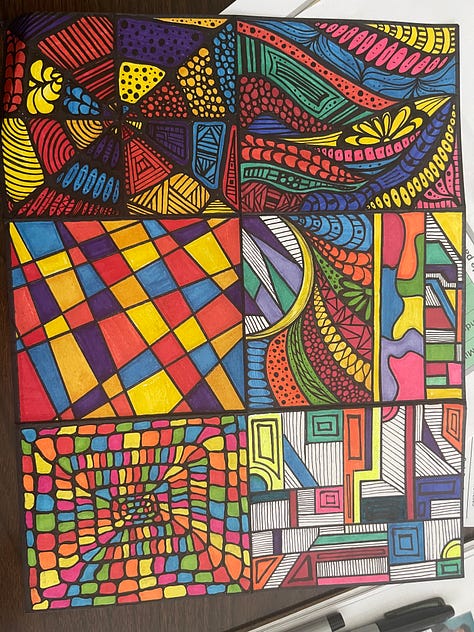
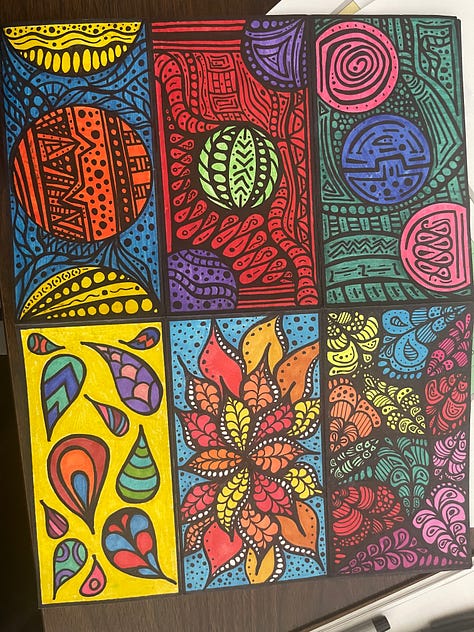
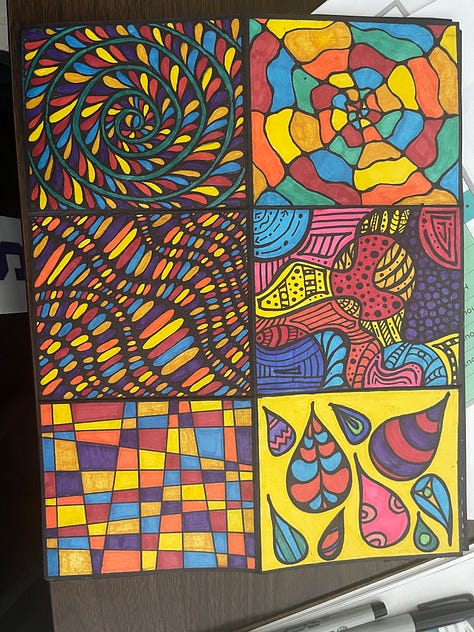
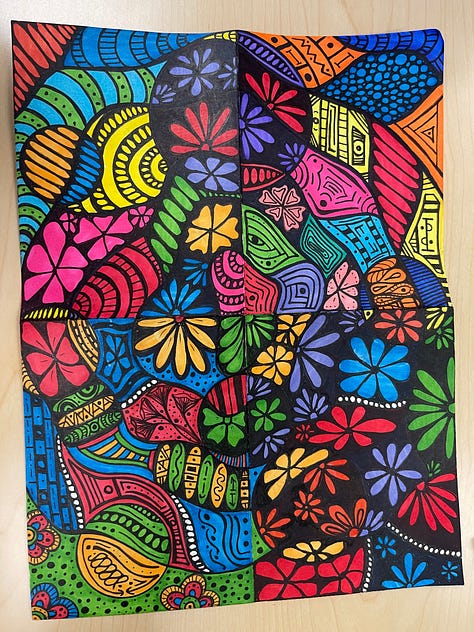
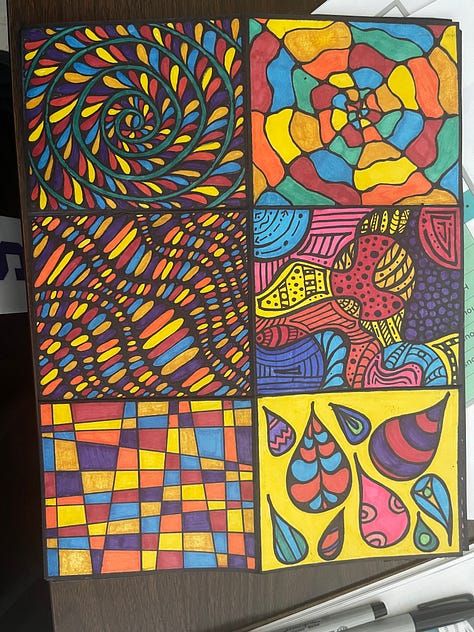


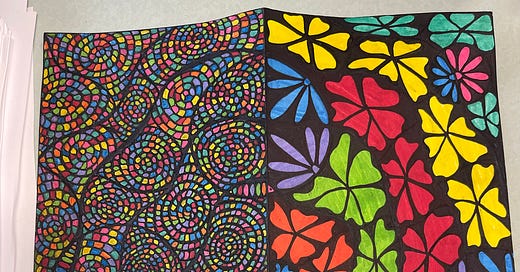



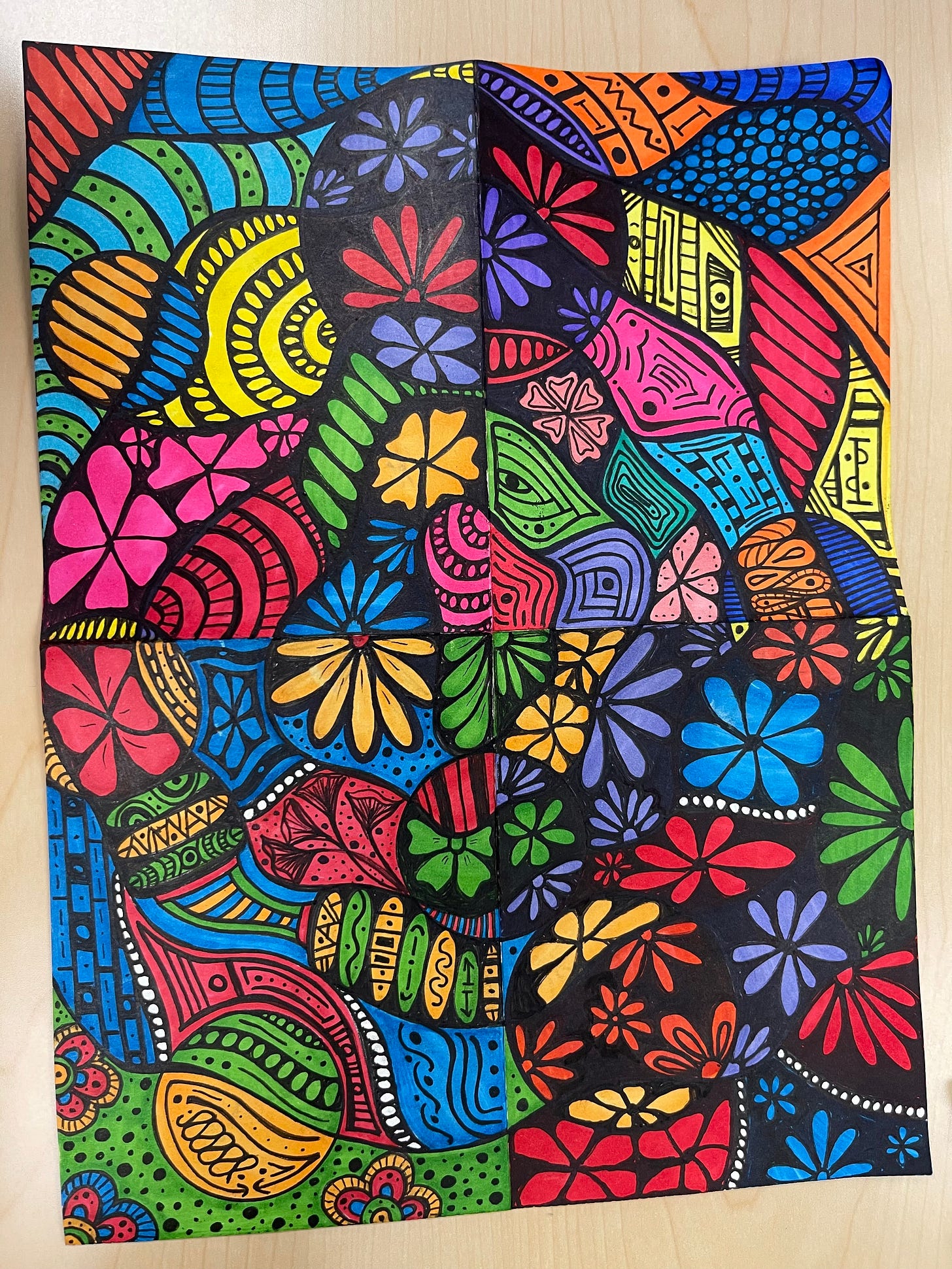
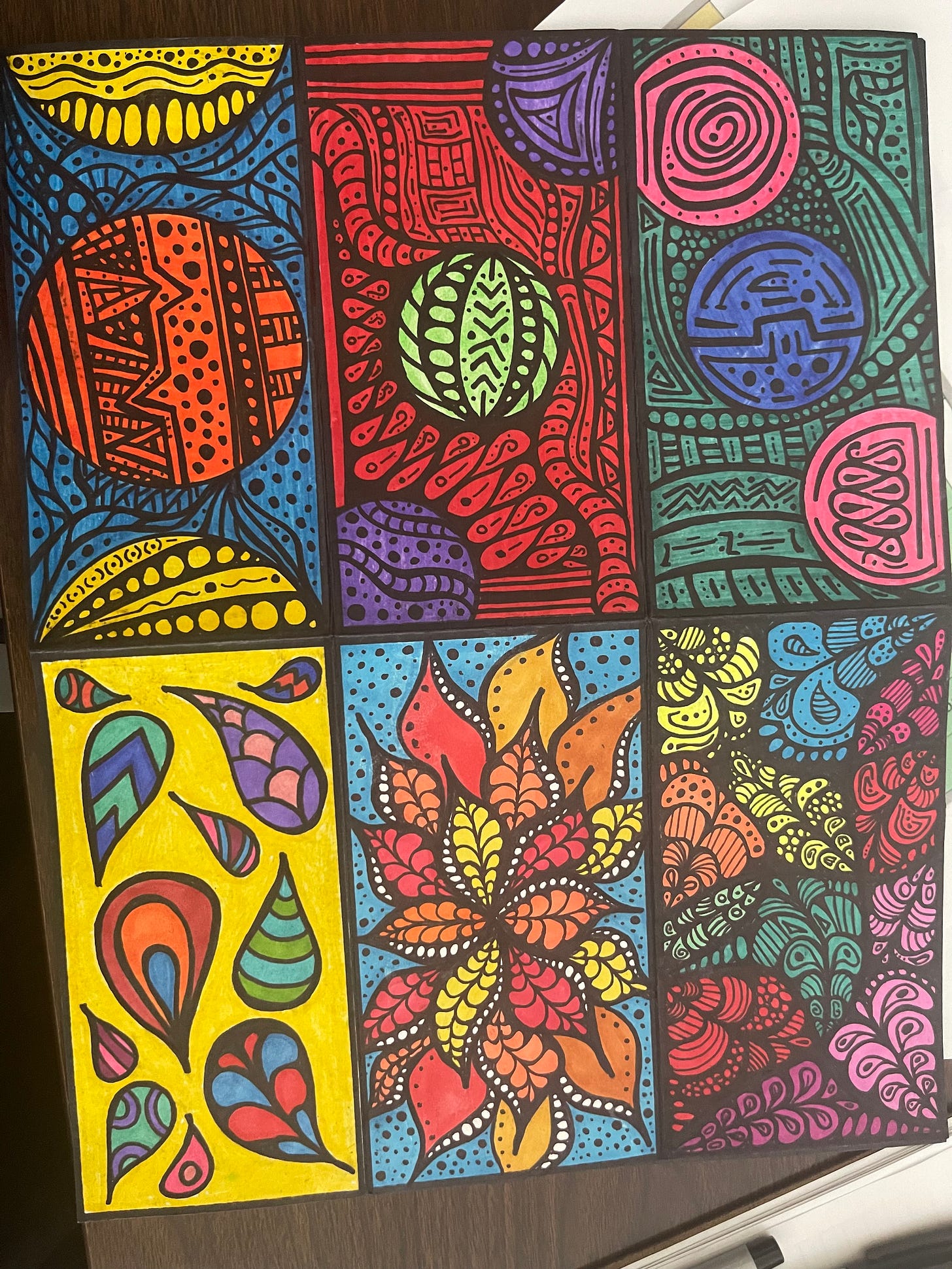
I rarely scroll through substack notes but today I did and saw your art. I was immediately drawn into it because I've been thinking about drawing or doodling or coloring for many months now, but have not dared to pick up a pen, staying safe in the prose that I write so comfortably. I have followed other artists but what they create seems too far from what I'm thinking: trees, people, landscapes, birds. Beautiful but I think it's not me. Then I saw your art and remembered the few things that I have made, always geometric lines, shapes and colors, which always pleased me. Following the note to this blog, I read about your journey from doodler to artist. I am drawn to the concept of doodling as a low bar to entry into art, and maybe this will help me get started. No promises! I'm just not sure how to take the first step. Thinking does get in the way. Thank you for this.
Reading your article, I am imagining that we all have a creative wellspring and when we identify as a writer or a musician, we might be surprised that with a little drilling, it can just as easily appear in a different form. I love the vibrancy of your colours and the shapes of your patterns.